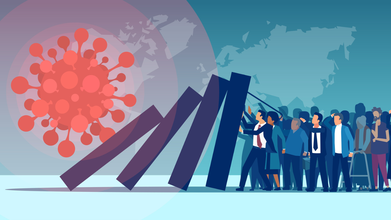- Health Conditions A-Z
- Health & Wellness
- Nutrition
- Fitness
- Health News
- Ayurveda
- Videos
- Medicine A-Z
- Parenting
Health Risks for Ageing Parents: Expert Tells How to Care for Them

Credits: Pexels
As you grow old, your health starts to deteriorate. Everything, whether it is your mental health or your physical health, starts to slow down. However, with age, your mental health gets overshadowed by your physical health.
Signs You Should Note
Neha Sinha, a dementia specialist and CEO and Co-founder of Epoch Elder Care, with the experience of 15 years notes that with age accessing social spaces becomes a hassle. “You are not able to go out because it is not accessible anymore or is not safe. This leads to loneliness. You start to withdraw from all social gatherings, and this leads to a deterioration in your mental health,” she points out.If you note these signs in your ageing parents or grandparents, take note of it. Try to get involved with them. It is also important to ensure that they have a separate social circle apart from the family. This way, they can have friends who they can also relate to.
With age, suggests Sinha, you are more prone to be depressed, and anxious. “Mental health conditions like schizophrenia or bipolar disorders are not something that happens when you grow older. You may have been living with these for the last 40 years, but the management differs, she suggests.
As you grow old, your symptoms start to overlap with other mental health conditions. For the proper treatment professionals use differential diagnosis, suggests Sinha. “The lines become blurred and to differentiate the symptoms from one mental health condition to another becomes difficult,” she says.
Preventive Measures
While there are ways like performing brain quizzes and optical illusions to keep your brain functioning, Sinha says that not many studies have been done on it. Thus, it cannot be guaranteed that it will help. However, it surely helps keep your brain active.There are also food habits like eating leafy vegetables, nuts, fish, virgin coconut and beans that help with brain functions.
Sinha suggests that keeping a social circle and continuing your hobbies can help your mind stay healthy. “Men especially face this issue, after they retire, they feel like they are at the loss of authority, and they start to lose control. It is thus important to keep doing things and learning a new skill to keep your brain active. While for women, since they continue taking care of the house, their brain stays active,” she says.
Cognitive stimulation is the key, especially to managing dementia, she notes.
“Just with weight training, you push your body and after a while, it becomes your muscle memory. Same with the brain. However, one should not get into solving too many puzzles, or trivia after being diagnosed with dementia. Because that would mean you are making your already injured brain exercise which might lead to agitation,” she recommends.
How to support?
It is important to know the ways you can support your ageing parents after they have been diagnosed.“The most important part is for the caregiver to understand what is happening and come to terms with the conditions. Because the elderly with cognitive conditions are not able to understand, they cannot be told or instructed to do anything. Thus, the responsibility is solely on the caregiver,” points out Sinha.
So, what can be done?
Awareness
Sinha suggests that the caregiver must understand that most cognitive conditions in ageing parents is progressive. “Even if you give your 200%, the condition will progress, you must not blame yourself for it. But you can delay the progression by creating a healthy environment.”Reach out to therapists and counsellors to know the ways to create such a healthy environment.
Be Patient
With progressive neurological conditions, the capability to communicate also deteriorates. “If you have a million words in your vocabulary, your parents might have a handful. So, it is important to pay attention to their needs,” she says.She suggests adopting the same approach that you do with kids and with your pets. This is when you focus on gestures, body language and mood over language. Due to cognitive disorders, parents experience a loss of language and the only way to communicate and to understand what they are communicating is through these means.
Be Empathetic
The earliest sign of dementia is short-term memory loss. “This means that your parents may not remember what they had or breakfast or if they had breakfast at all. But they will remember their childhood stories. You may be confused if there is at all a memory loss since they remember old stories, and you might think they are doing this on purpose. But this is not the case,” she says.Create a healthy environment by agreeing with them and listening to their stories. The responsibility of creating a safe environment is totally with you.
There might be times when your parents may do socially unacceptable or non-compliance behaviour. But it is important to understand the triggers and ensure that the triggers do not occur anymore.
Help Them Stay Fit
It is important that they physically stay well, and do not get any infections or don’t suffer a fall. For that, you can use the help of technology like motion sensors. GPS tracker is another way you can keep a check on them. “There is a tendency of wandering off and being unable to find your way back. In these cases, a GPS tracker can help,” she says.These 5 Trends Could Shape Healthcare In 2026

Credits: iStock
As we step closer to 2026, let us look at what healthcare trends could shape the upcoming year. The 2026 healthcare trend will follow or shape on challenges that 2025 threw on us, these included a surge in lifestyle diseases, continuous cases of non communicable diseases, which are preventable, and a rise in infectious diseases. Based on them, the predictions of 2026 healthcare trends can be made.
Preventive Care Will Matter The Most
In 2026, healthcare will look most at prevention. As a significant portion of diseases, like the NCDs or the non communicable diseases, which also include half of all the cancers are preventable. This includes changes in lifestyle habits, including food habits, dietary fiber intake, exercise, and maintaining a regular sleep cycle.
Careful Use Of GLP-1 Medication
2025 saw a surge in the use of GLP-1 medication, however, this year also saw many reported unusual side effects of the medication. The year 2026 will emphasize more on the correct use of the medication, as well as, what areas must one pay heed to, especially after the medications have been stopped.
Also Read: These Are The 7 Common Mistakes People Make After Stopping Their Weight Loss Jabs
Shift In Patient Coverage
In the US, new changes have been done in Medicaid and its eligibility, which might change the rules on potential expiration of advanced premium tax credits. This may mean that many patients could become uninsured, or underinsured. Moreover, other changes in the coverage may include GLP-1 medication, as on November 6 of 2025, President Trump announced deals with Eli Lilly and Novo Nordisk slashed prices and brought coverage to eligible beneficiaries for just a $50 copay, down from $1,000 per month, out of the pocket.
DIY Skincare
Experts, like board-certified plastic surgeon John Diaz, MD, tells Cosmopolitan that 2026 will see a rise in DIY skincare trends. This would be making skincare products yourself, which could include yogurt face masks, to kitchen-sink sunscreen. However experts have pointed out that products which are not backed by science or have used ingredients without a correct measure could do more harm than good to the skin. “Many people who tried DIY skincare found these treatments to be inconsistent or ineffective. At the end of the day, consumers want efficacy, which drives them towards products formulated with scientifically proven ingredients," says the doctor.
Annual Testing To Become A Norm
In 2025, there were many cases of young people experiencing strokes and hear attacks. This has shifted the conversation on annual testing, regular screenings, and blood works for people who may fit the traditional definition of "healthy". Many people under the age of 40 have also reported cancer, which is what makes early screenings, annual testing, and blood work more important to ensure that everything in the body is working smoothly.
While getting checked once a year is not a new concept, however, it was mostly common in older adults, but now more young adults are also now considering getting annual tests done, as they are easily available and can help detect severe illness early.
You May Like To Read: Did Scientists Just Come Up With A New Blood Test That Detects And Monitors Lung Cancers In Real Time?
Adenovirus: Highly Contagious Mystery Illness Spreading Fast, Watch Out for These 12 Symptoms

Credits: Canva
The so-called “mystery virus” behind lingering sore throats, blocked noses filled with mucus, and days of exhaustion is actually well known to doctors. According to Eric Sachinwalla, medical director of infection prevention and control at Jefferson Health, the culprit is adenovirus.
What makes this virus particularly difficult to control is how tough it is. Adenovirus can survive soap and water, withstand many everyday disinfectants, and linger on contaminated surfaces for long stretches of time. Below is what experts know so far about this fast-spreading infection.
What Is Adenovirus?
Adenovirus refers to a group of common viruses that usually trigger cold- or flu-like illness. It spreads easily because it is far more resilient than many other viruses. Ordinary soap, water, and standard disinfectants do not reliably destroy it, allowing it to persist in the environment. As a result, infections often cluster in places where people spend time close together, such as daycares and military barracks. The virus spreads through the respiratory tract, can be shed in stool, and can survive for some time on contaminated surfaces, according to the CDC.
Adenovirus: What Are The Symptoms Of Adenovirus?
“Adenovirus is a typical virus that causes common cold or flu-like symptoms,” says Dr Deborah Lee at Dr Fox Online Pharmacy. That does not mean adenovirus is the same as a cold. Instead, adenovirus is one of many germs that can cause cold-like illness. A simple way to think about it is that a “cold” describes the symptoms, while adenovirus is one specific virus that can lead to them.
Symptoms can vary depending on the subtype involved. While there are more than 100 known subtypes, only 49 infect humans. Dr Lee notes that people may experience any of the following:
- Fever
- Runny nose
- Sore throat
- Swollen cervical lymph nodes in the neck
- Cough
- Shortness of breath
- Conjunctivitis
- Ear pain
- Diarrhoea
- Vomiting
- Stomach pain
- Urinary tract infection
Adenovirus? Is It Contagious?
“Adenovirus infection is highly contagious,” Dr Lee explains. “It spreads by breathing in infected droplets, by touching the virus and then rubbing the eyes, or through the faecal-oral route, often due to poor hand hygiene after using the toilet.”
She adds that the virus spreads quickly in crowded settings where people are in close contact. To eliminate adenovirus from surfaces, Dr Lee recommends stronger cleaning agents such as bleach-based solutions or hydrogen peroxide. “The virus is resistant to soap and many commonly used cleaners,” she says.
To reduce the risk of catching adenovirus or other respiratory infections currently circulating, Dr Lee advises staying away from people who are unwell. She also suggests the following precautions:
- Avoid touching your face and nose
- Use a clean tissue to blow your nose and dispose of it immediately
- Wash your hands often with soap and warm water, then dry them thoroughly, especially after using the toilet or changing nappies
- Clean children’s toys regularly
- Disinfect worktops, changing areas, toilets, and bathrooms
- Avoid sharing cups, plates, food, or towels
- Wear a mask if you need to go out while unwell
- Keep windows open and ensure rooms and workspaces are well ventilated.
Top 5 Health Crises That Impacted the World in 2025

Credits: iStock
As we soon step into 2026, it is time to look back at which diseases took over the world in 2025. These diseases evolved throughout the year, and led to complex challenges. Here, we explore the top 5 health crisis in 2025.
Infectious Diseases, Outbreaks, and COVID-19
This year, COVID-19 continued to make headlines, along with COVID, flu and measles too continued to infect people. In fact, new variants of COVID and flu have circulated across the world, leading to new kinds of symptoms, including razor-blade like throats in COVID-19. Influenza too surged up across US, UK, and Canada, with hospitalization rates going up. A new subclade K strain is seen responsible for this surge. Measles, too is a highly contagious, however, vaccine-preventable respiratory virus resurged this year, and this disease, which was once eliminated from the US, has come back due to lower rates of vaccination.
Tuberculosis Outbreak
A tuberculosis outbreak in the Kansas City metro area resulted in dozens of cases. This has led to two deaths, as reported by the Kansas Department of Health and Environment (KDHE). In fact, Michael A Bernstein, MD, director of pulmonary and critical care at Stamford Health said that many people assume that TB is rare and no longer a concern, however, it still remains common.
Also Read: Top 5 Infectious Diseases That Disrupted Healthcare System Worldwide In 2025
Bird Flu
In the US, the first death from bird flu was reported by the Louisiana Department of Health. The Centers for Disease Control and Prevention (CDC) reported that the individual was older than 65 years and had underlying medical conditions. That person developed severe illness and was hospitalized following the exposure to a noncommercial backyard flock and wild word. In fact, new studies have shown that bird flu viruses could have a potential risk for humans and may become next pandemic. This comes from two different studies, one done by the universities of Cambridge and Glasgow that show how avian flu strains are multiplying even when the body temperatures could hinder viruses. Whereas, another important study led by Indian scientists, by Philip Cherian and Gautam Menon of Ashoka University, published in BMC Public Health predict if H5N1 or the bird flu virus, could start spreading among humans.
Antimicrobial Resistance (AMR)
In 2025, AMR has worsened and the resistance has risen over 40% of monitored pathogen-antibiotic pairs between 2018-2023. Due to the resistance, common infections become harder to treat, especially in regions like Southeast Asia, with India facing high rates. The World Health Organization (WHO) report notes that AMR is a growing threat to global health, and draws on more than 23 million bacteriologically confirmed cases of bloodstream infections, urinary tract infections, gastrointestinal infections, and urogenital gonorrhoea.
Non Communicable Diseases or NCDs
NCDs like heart disease, cancer, diabetes, and respiratory illnesses remained a persistent global health challenge in 2025. Trends to showed a continued rise driven by unhealthy lifestyles, which included processed food, inactivity, tobacco or alcohol, and urbanization.
© 2024 Bennett, Coleman & Company Limited

